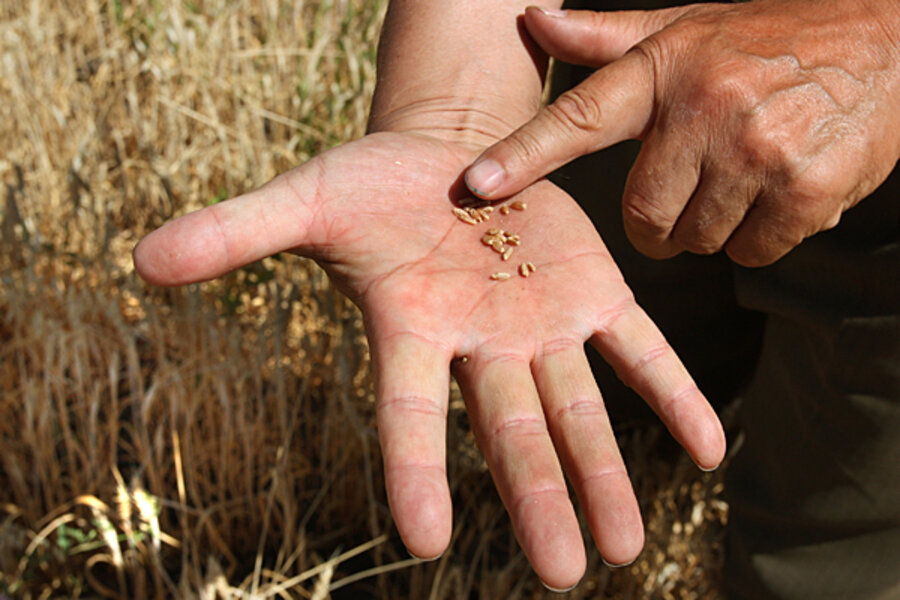Wheat prices soar: How will that affect the grocery bill?
Loading...
| New York
A loaf of bread could soon cost more money out of your pocket if the price of wheat continues its recent spike upward.
Since early July, the price of wheat, used to make flour, has jumped about 75 percent. On Thursday, the price on the Chicago Board of Trade, a futures market, rose more than 12 percent from Wednesday, closing at $8.15 per bushel, the highest level in two years.
Behind the rise on Thursday was Russia's announcement that it was temporarily banning wheat exports because of a drought. Russia is the world’s largest exporter of the grain.
If the price hike holds, the consequences could potentially be felt worldwide. Poor people around the globe – and the organizations that help them – will have a more difficult time affording basic food such as bread. Eventually, the price of food made from wheat in the US could start to rise, although the wheat in a loaf of bread is less than one-quarter of that loaf's cost. It might also mean that US farmers, with the likelihood of a good harvest this year, could take advantage of the high prices to pay off debt and make money.
“This run-up has caught everyone in the marketplace by surprise,” says Bill Lapp, an economist and founder of Advanced Economic Solutions in Omaha, Neb. “We don’t know how large the crop will be in Russia, the Ukraine, or Kazakhstan, and until we have an idea, we will have extreme volatility and the potential for higher prices.”
In some ways, the price run-up is reminiscent of February 2008, when the price of some grades of wheat shot up 90 percent, peaking at $24 a bushel. Back then, the price rose partly because of drought conditions in Kansas and Oklahoma and partly because of a poor harvest in other parts of the world. It did not help that the US dollar was weak, making US grains relatively cheap on the world market.
This time, however, some wheat users see another reason for the rise: speculators in the commodity markets. According to Robb MacKie, president and CEO of the American Bakers Association, commodity index funds have entered the futures markets, buying up 400 percent of the available supplies of wheat. Commodity index funds purchase a large basket of commodities, perhaps to hedge against inflation or for other reasons.
“We have been rapidly trying to get the Commodity Futures Trading Commission to put some limits on these index funds,” says Mr. MacKie. “All we have gotten is a few slices of the loaf, in that now they have to be more transparent.”
Until early July, MacKie was expecting wheat prices to behave, perhaps even to fall. Inventories of wheat are at a 23-year high. US farmers have been increasing their acreage devoted to wheat. But now, he says, the tide has turned. “The agricultural economists we rely on so our members know when to buy are all saying this is 2008 all over again.”
When commodity futures rise, consumers usually don't see an increase in prices on the shelves right away. But MacKie says the surprise price jump for wheat may mean the impact is felt sooner rather than later.
So far, some bakers say they haven’t noticed a difference. Abe Faber of Clear Flour Bakery in Brookline, Mass., says he is paying the same price for a 50-pound bag of high-quality flour that he has been all year. Moreover, he notes, flour represents only about 12 to 14 percent of the cost of a loaf of his bread.
“If it doubles, that could add to the cost,” he says, “Now, we’ll keep an eye on this.”
The grocery chain Wegman’s is not making any “hasty decisions” to raise prices but is keeping an eye on the grain markets, says Jo Natale, a spokeswoman for the Rochester, N.Y.-based chain.
In poorer parts of the world, however, the rising price of the grain could affect a large number of people, says Thom Leonard, a milling and baking consultant in Lawrence, Kan. “For people whose staple is flour, grain, or simple breads, their food budget may be already 80 percent of their income,” he says. “For poor people around the world, this rise in the price of wheat is a real issue.”
Some farmers in the US and Canada will likely benefit from the higher prices if they have not already sold their wheat, says Mr. Lapp, the economist. If the price stays high, he says, “I would expect some supply response in the next 6 to 12 months.”





